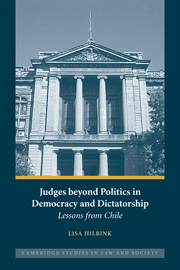Book contents
- Frontmatter
- Contents
- Acknowledgments
- Introduction
- 1 The Judiciary, the Rule of Law, and Democracy: Aspirations and Impediments
- 2 The Institutional Construction of the Judicial Role in Chile
- 3 Conservative Activism in the Heyday of Democracy, 1964–1973
- 4 Legitimizing Authoritarianism, 1973–1990
- 5 Continuity and Change after the Return to Democracy, 1990–2000
- 6 Conclusions and Implications
- Appendix A Orienting Information on Chilean Law and Courts
- Appendix B List of Interviewees (alphabetical by category)
- References
- Index
2 - The Institutional Construction of the Judicial Role in Chile
Published online by Cambridge University Press: 08 January 2010
- Frontmatter
- Contents
- Acknowledgments
- Introduction
- 1 The Judiciary, the Rule of Law, and Democracy: Aspirations and Impediments
- 2 The Institutional Construction of the Judicial Role in Chile
- 3 Conservative Activism in the Heyday of Democracy, 1964–1973
- 4 Legitimizing Authoritarianism, 1973–1990
- 5 Continuity and Change after the Return to Democracy, 1990–2000
- 6 Conclusions and Implications
- Appendix A Orienting Information on Chilean Law and Courts
- Appendix B List of Interviewees (alphabetical by category)
- References
- Index
Summary
The Chilean judiciary, in its basic institutional structure, is the oldest in Latin America. In 1974, the Supreme Court celebrated “150 years of uninterrupted institutional life” (Sesquicentenario de la Corte 1974), making it by at least one account “the most stable institution in Chile” (Bravo Lira 1990: 36). In a region known for its political and institutional instability, this is certainly remarkable. Yet, as this book reveals, this century and a half of stability did not come without a price. Indeed, as Chile evolved from a quasi-authoritarian republic (in the 1830s) to one of the world's most vibrant democracies (in the 1960s), the judiciary proved to be not merely stable but sclerotic.
This chapter begins to make this point by offering a brief history of the institutional development and political role of Chile's judiciary from the dawn of the republic to 1964 (the year my primary analysis begins). My objective is to show that long before General Pinochet arrived on the scene, the stage was set for judicial cooperation with his regime. As I will explain, nineteenth-century Chilean statebuilders and twentieth-century reformers constructed the judiciary around the ideal of “apoliticism.” This institutional construction, in which judges were, first, ideologically and, later, structurally, separated from political life, discouraged independent thinking and innovation, and, instead, reproduced conservatism and conformity. Judges had neither the professional understandings nor incentives to do anything but accept and emulate the traditional perspectives and practices of the institutional elders.
- Type
- Chapter
- Information
- Judges beyond Politics in Democracy and DictatorshipLessons from Chile, pp. 41 - 72Publisher: Cambridge University PressPrint publication year: 2007

